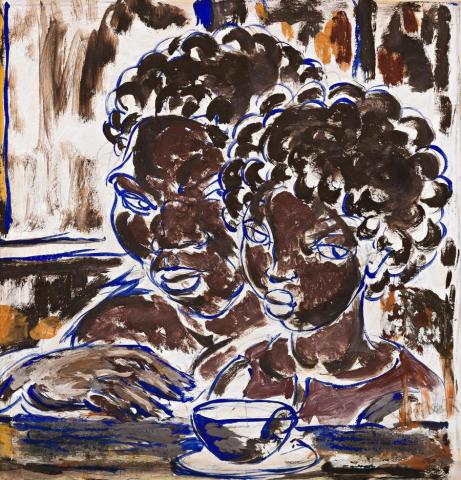LANDLADY AND DAUGHTER, CAIRNS, 1941
IAN FAIRWEATHER
gouache and pencil on paper
41.5 x 40.0 cm
signed lower right: I Fairweather
Collection of Lina Bryans, Melbourne
Thence by descent
Private collection, Melbourne
Fairweather: a Retrospective Exhibition, Queensland Art Gallery, Brisbane, 3 June – 4 July 1965; Art Gallery of New South Wales, Sydney, 21 July –22 August 1965; National Gallery of Victoria, Melbourne, 9 September – 10 October 1965; National Gallery of South Australia, Adelaide, 26 October – 21 November 1965; Western Australian Art Gallery, Perth, 9 December 1965– 16 January 1966; Tasmanian Museum and Art Gallery, Hobart, 10 February – 13 March 1966,cat. 82 (label attached verso)
The Drawings of Ian Fairweather, National Gallery of Australia, Canberra, 21 June – 24 August 1997; Art Gallery of New South Wales, Sydney, 17 October– 7 December 1997; Queensland Art Gallery, 7February – 29 March 1998 (label attached verso)
Escape Artists: Modernists in the Tropics, Cairns Regional Gallery, Queensland, 30 May – 30 August 1998; Rockhampton City Art Gallery, Queensland, 23 September – 31 October 1998; Brisbane City Gallery, Brisbane, 21 November1998 – 10 January 1999; Mosman Regional Gallery, Sydney, 19 January – 24 February 1999; Ballarat Fine Art Gallery, Victoria, 5 March – 9 May1999; Perc Tucker Regional Gallery, Townsville,21 May – 27 June 1999 (label attached verso)
Fisher, T., The Drawings of Ian Fairweather, National Gallery of Australia, Canberra, 1997, p. 23 (illus.)
Wilson, G., Escape Artists: Modernists in the Tropics, Cairns Regional Gallery, Queensland, 1998, pp. 35–37, 180 (illus.)
Bail, M., Fairweather, Murdoch Books, Sydney, revised edition 2009, pp. 59,61, 62, 248, cat. 46, pl. 38 (illus.)
Ian Fairweather's Landlady and Daughter, Cairns was painted in Calcutta in 1941. It was a time of reflection on previous years in China presented in a series of major paintings and drawings such as the beautifully elusive (Bridge at Foochow), c1941 in the National Gallery of Australia, Canberra, and the masterly Bridge, Huchow, 1941 in the National Gallery of Victoria, Melbourne. The Australian inspired subject, Landlady and Daughter, Cairns has been hailed as one of the best. In the catalogue to the touring exhibition, The Drawings of Ian Fairweather, Tim Fisher of the National Gallery of Australia wrote about the work with such perception and appreciation that it is worth quoting in full. 'The apotheosis of the Indian group of drawings can be found in four of the most beautiful works in the exhibition. Sketch head, c1941 and Landlady and daughter, Cairns, 1941 are affectionate portraits drawn from Fairweather's relatively recent memory of the Aboriginal family with whom he had shared his boathouse at Alligator Creek. Both works are made with a determined simplicity and without hint of condescension. A few, delicate, calligraphic strokes of intense Reckitts blue or dense black trace the pencil under-drawing, followed by expressive infilling with dark gouache. Whereas the 1930s oil paintings needed an inscribed surface drawing to solidify the image, in Sketch head and Landlady with daughter, Cairns, drawing is embodied within the image. Individual pencil or gouache marks, and the figures as whole, seem to be illuminated by the abuttal of white ground and deep colour.'1 Fairweather paints with a deeply felt humanity, the affection of the mother for her child expressed through the closeness of forms, direction of eyes and gesture of the hand.2 The seeming simplicity and brevity of the technique encompass the mood and give it an immediacy readily felt by the viewer. Added to that the foreground prominence of the cup and saucer provide an infectious, if not witty informality.
In Landlady with Daughter, Cairns, and Lads Boxing, 1939 (private collection), Murray Bail drew attention to Fairweather as 'the first major Australian artist who felt any merit in painting Aborigines, or the Islanders, without a hint of condescension.'3 He continued, 'Fairweather's landlady was black, and after fighting with a daughter, moved into the boathouse with mattress and two other daughters. Fairweather's affectionate sketch, painted in gouache from memory several years later, is made noble by the tracing line of ultramarine.' Fairweather's remarkable feeling for and understanding of native children and people was seen earlier in such gentle works as Smiling Girl, 1926, Holmes à Court Collection, Heytesbury, (Mother and Child), c1926, Museum of Old and New Art, Hobart, and the extraordinary moving Balinese Woman, c1933 in the same collection. While Arthur Boyd showed compassion for the plight of the Aboriginal people, and Russell Drysdale admired and ennobled them, Fairweather painted them as equals.
1. Fisher, T., The Drawings of Ian Fairweather, National Gallery of Australia, Canberra, 1997, pp. 10-11
2. In his catalogue of Fairweather's works, Murray Bail records that this painting was 'brought to Melbourne by Fairweather in 1943'. The daughter he identified as 'now Mrs Lala Nicol, Mossman, Queensland'. Bail, M., Fairweather, Murdoch Books, Sydney, revised edition 2009, p. 248
3. Bail, M., ibid, p. 59
DAVID THOMAS
